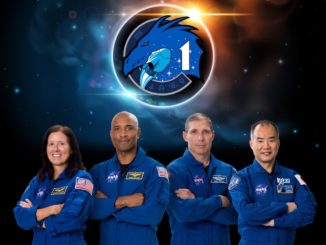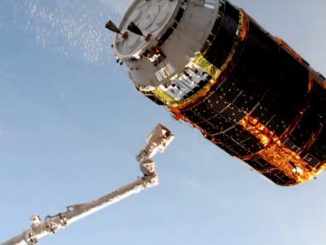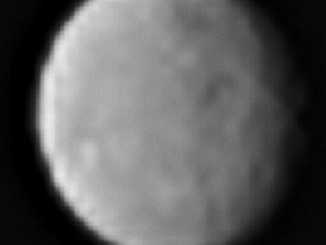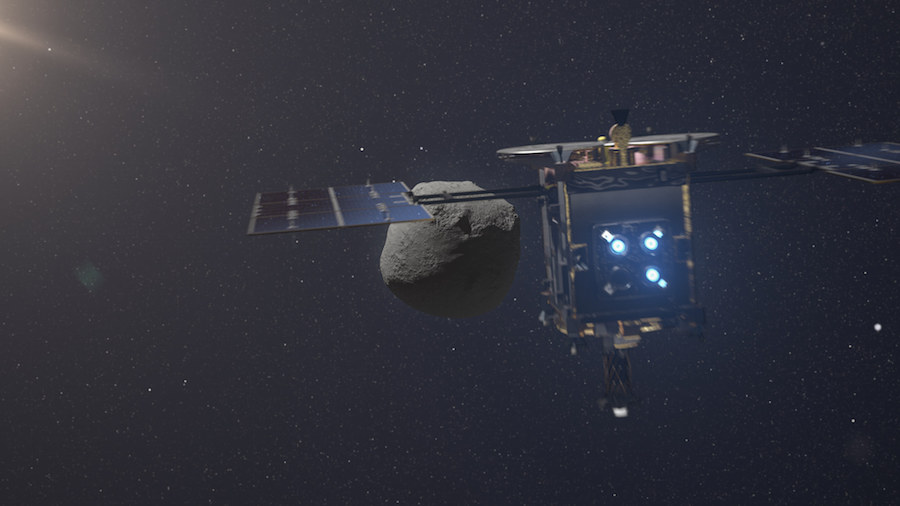
A German-built landing probe the size of a microwave oven carrying a camera and a suite of scientific instruments was closing in on asteroid Ryugu Tuesday, riding aboard Japan’s Hayabusa 2 spacecraft to join two other robots deployed to the asteroid’s surface last month.
The Mobile Asteroid Surface Scout, or MASCOT, is set to be released from the Japanese Hayabusa 2 mothership at 0158 GMT Wednesday (9:58 p.m. EDT Tuesday) for a free-fall final descent to the asteroid, with its landing velocity tempered by Ryugu’s tenuous gravity field.
A few minutes later, MASCOT will reach Ryugu, and will likely bounce several times before coming to a rest.
The battery-powered robot is set to land on the asteroid a week-and-a-half after a pair of Japanese landers — each one even smaller than MASCOT — touched down on Ryugu and beamed back the first-ever images from the surface of an asteroid.
MASCOT carries four instruments, and if it functions as designed, the lander will capture wide-angle color photos from Ryugu’s craggy surface, collect measurements to determine if Ryugu’s boulders emit a magnetic field, gather temperature and thermal information, and analyze the composition of the asteroid surface.
Launched in a carrying bay aboard Hayabusa 2 in December 2014, the MASCOT lander has been powered up and tested to ensure its instruments are ready for action. But the robot is heading into a hazardous environment on Ryugu, an asteroid that circles sun mostly between the orbits of Earth and Mars, and spans around 3,280 feet (1 kilometer) in diameter along its equator and approximately 2,880 feet (880 meters) from pole-to-pole.
The airless landing site selected for the European-made robot lies in Ryugu’s southern hemisphere, with a temperature range between minus 81 degrees Fahrenheit (minus 63 degrees Celsius) to 145 degrees Fahrenheit (47 degrees Fahrenheit), comfortable enough for MASCOT to survive for at least 16 hours.
But Hayabusa 2’s reconnaissance of Ryugu since the mission’s arrival at the asteroid in June has revealed a landscape strewn with boulders, introducing hurdles for hopping landers like MASCOT.
“MASCOT has to endure quite a bit on the surface,” said Ralf Jaumann, principal investigator for the MASCOT lander at DLR, the German Aerospace Center. “Ryugu has very, very large boulders lying around. These will be like mountains for little MASCOT when it’s on the surface. These boulders can be up to 40 meters (131 feet) tall.”
Once it settles on the asteroid, MASCOT will use a mechanism to orient itself upright, then hop across Ryugu, exploring up to several different locations before its power supply runs out. MASCOT’s lifetime is limited by the capacity of its battery, and it does not carry solar panels to recharge.
Scientists had to balance the needs of MASCOT’s four instruments to pick a landing zone, which also had to be clear of sites where Hayabusa 2 itself will attempt touch-and-go maneuvers in the coming months to collect samples for return to Earth.
“We are anxious to see whether MASCOT will slide out of its supporting frame smoothly, as we have planned and tested so extensively,” said Tra-Mi Ho, MASCOT’s project manager at DLR. “A smooth descent is crucial, otherwise MASCOT will bounce back up from the asteroid like a rubber ball due to the low gravitational pull, and be lost in space.”
Scientists have calculated that Ryugu’s gravity field is 80,000 times weaker than Earth’s, making operations in the asteroid’s vicinity more akin to a docking in space than a landing on a planet.
“We’re entering a world that no one has ever seen before,” said Christian Krause, MASCOT operations manager at DLR. “This is a single shot, everything has to work. We will simply be ejected. In principle, it desn’t matter how we land on the surface.”
MASCOT is a joint project between DLR and CNES, the German and French space agencies, and includes many of the same engineers and scientists who developed the larger Philae lander that flew to comet 67P/Churyumov-Gerasimenko with the European Space Agency’s Rosetta spacecraft.
Philae landed on the comet in November 2014, less than a month before the launch of MASCOT, which officials have nicknamed Philae’s “little brother.”
MASCOT has a mass of around 22 pounds (10 kilograms) and measures 11.8 inches (30 centimeters) by 11.8 inches by 7.9 inches (20 centimeters).
“MASCOT is a small box about as big as a microwave oven,” Jaumann said.
A team of controllers stationed at DLR’s space center in Cologne, Germany, will monitor MASCOT during its exploration of Ryugu. They will decide whether to dispatch the lander to a different location, using a swing arm designed to generate momentum for hops in the asteroid’s ultra-low gravity.
“In the final tests before the landing, we estimated that we would probably only let MASCOT perform one jump of less than 10 meters (32 feet), in order to preserve the battery life and ensure the optimal execution of the measurements and data transfer,” Ho said. “What is more, recent images suggest that the surface of Ryugu has a rather uniform composition everywhere, so we do not need to perform big jumps.”
In preparation for MASCOT’s deployment, Hayabusa 2 started approaching asteroid Ryugu early Tuesday from a range of 12 miles (20 kilometers), heading for a position less than 200 feet (60 meters) from the asteroid, where it will release the lander for its unpowered descent.
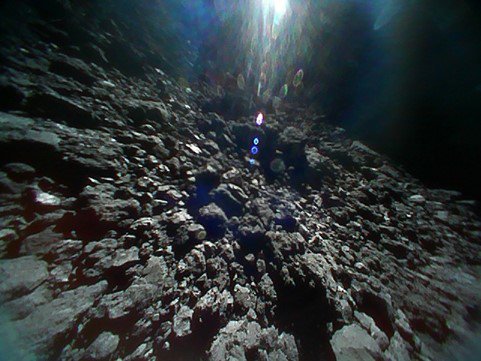
Officials from the Japan Aerospace Exploration Agency, which leads the Hayabusa 2 mission, released more pictures from a pair of mobile robots Thursday, several days after their landings on Ryugu.
The imagery reveals an uneven surface, with numerous rocks and boulders of various sizes. JAXA’s update on the MINERVA-II-2 rovers last week indicated they were still functioning, with the help of solar panels to generate electricity.
Like MASCOT, the MINERVA-II-1 rovers carry internal mechanisms to hop across the asteroid, rather than wheels like the ones used on rovers driving on Mars. All of the landers communicate with Earth through the Hayabusa 2 mothership.
Ryugu is currently located 202 million miles (around 325 million kilometers) from Earth, and it takes approximately 16 minutes for a radio signal to cover the distance from Hayabusa 2 to Earth.
The low data rate link between Hayabusa 2 and MASCOT, coupled with the need to communicate with the Hayabusa 2 spacecraft itself, will mean scientists must wait a few days to receive measurements and photos from the lander. But controllers in Cologne, which will be linked with the Hayabusa 2 command center in Sagamihara, Japan, expect to receive confirmation Wednesday that MASCOT successfully deployed and reached the asteroid’s surface.
“This is a completely different world,” Jaumann said. “It’s, very very far away, and we haven’t seen anything like it before. When the first image comes in, and you see the surface, it could certainly look like a pile of rubble, but it is an extremely exciting pile of rubble. So I am really looking forward to seeing the first pictures.”
Email the author.
Follow Stephen Clark on Twitter: @StephenClark1.

